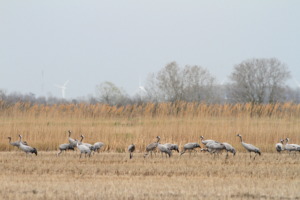Since 2007, the Tour du Valat has been coordinating the census of wintering common cranes in the Camargue. Some forty people, volunteers or employees of the Tour du Valat, the Réserves naturelles nationales de Camargue et des marais du Vigueirat, the Parc naturel régional de Camargue and the Syndicat mixte pour la protection et la gestion de la Camargue gardoise, take part in the count at dawn on the same day, near the cranes’ dormitories (nocturnal gathering areas), to count them as they fly off to their feeding grounds.
These censuses show that crane numbers in the Camargue are rising sharply, with over 26,000 cranes counted in 2023, compared with just 300 in 2007. In just a few years, the Camargue has become the main wintering site for cranes in France, ahead of the Lac du Der-Chantecoq in Champagne and the Arjuzanx site in Aquitaine. While this increase represents a potential boost to the region’s eco-tourism and economic development in winter, it also raises fears about the damage these birds could cause to crops.
Cranes are a farmer’s ally when they feed in rice stubble: they consume harvest residues and weed seeds, while improving the soil with their droppings. On the other hand, when they settle in winter seedlings (wheat, rapeseed or faba beans), they are likely to cause damage by trampling or consuming seeds.
To identify the factors influencing the presence of cranes in crops, the Tour du Valat conducted a study with the support of the Prince Albert II of Monaco Foundation [1] (Initiative Homme-Faune Sauvage) on a sample of 254 plots, visited 14 times each, during the winter of 2021-2022. Although the sampled areas of rice and wheat stubble plots are similar, it appears that rice stubble plots are frequently visited (20% occupied on average), particularly in the depths of winter, in January. Wheat plots, on the other hand, are rarely visited by cranes (in less than 2% of cases). These rare visits occur mainly on late wheat sowings, sometimes causing significant damage.
On March 27, an information meeting on cranes was held at the Scamandre discovery center [2], bringing together around twenty stakeholders and partners. Organized by CEFE-CNRS [3], the Syndicat mixte pour la protection et la gestion de la Camargue gardoise [4], the Parc naturel régional de Camargue [5] and Tour du Valat, and attended by farmers’ representatives from the Gard and Bouches-du-Rhône regions, the meeting began by sharing the knowledge of farmers, protected area managers and representatives of the French government and the Office Français de la Biodiversité on the causes and consequences of the presence of sandhill cranes in the Camargue. Next, the results of the study into the determinants of crane distribution were presented and discussed with the farmers, with a view to developing possible solutions to facilitate cohabitation between cranes and farmers.
For example, delaying the tillage of rice stubble would keep the cranes on this attractive land, where their presence is quite beneficial to farmers. The additional costs or loss of earnings associated with delayed soil preparation for subsequent crops could be covered by agri-environmental measures and be part of a tourism development policy. Frightening methods were discussed, which could be the subject of a derogation after application to the administrative authorities, as has been the case for several years for the Greater Flamingo.
This study was carried out with financial assistance from the Prince Albert II of Monaco Foundation as part of the Man-Wildlife Initiative. The contents of this article are the sole responsibility of Tour du Valat.
